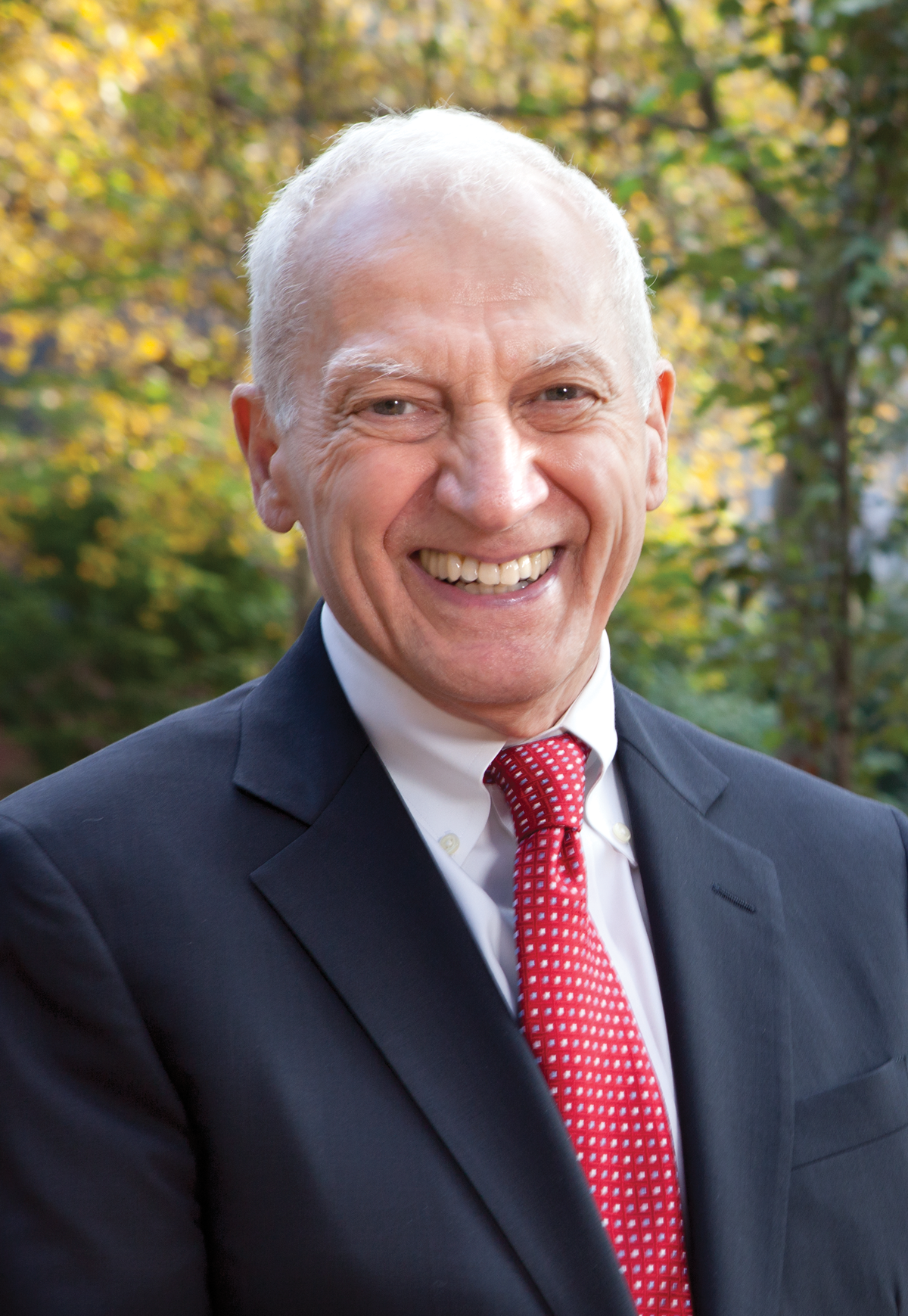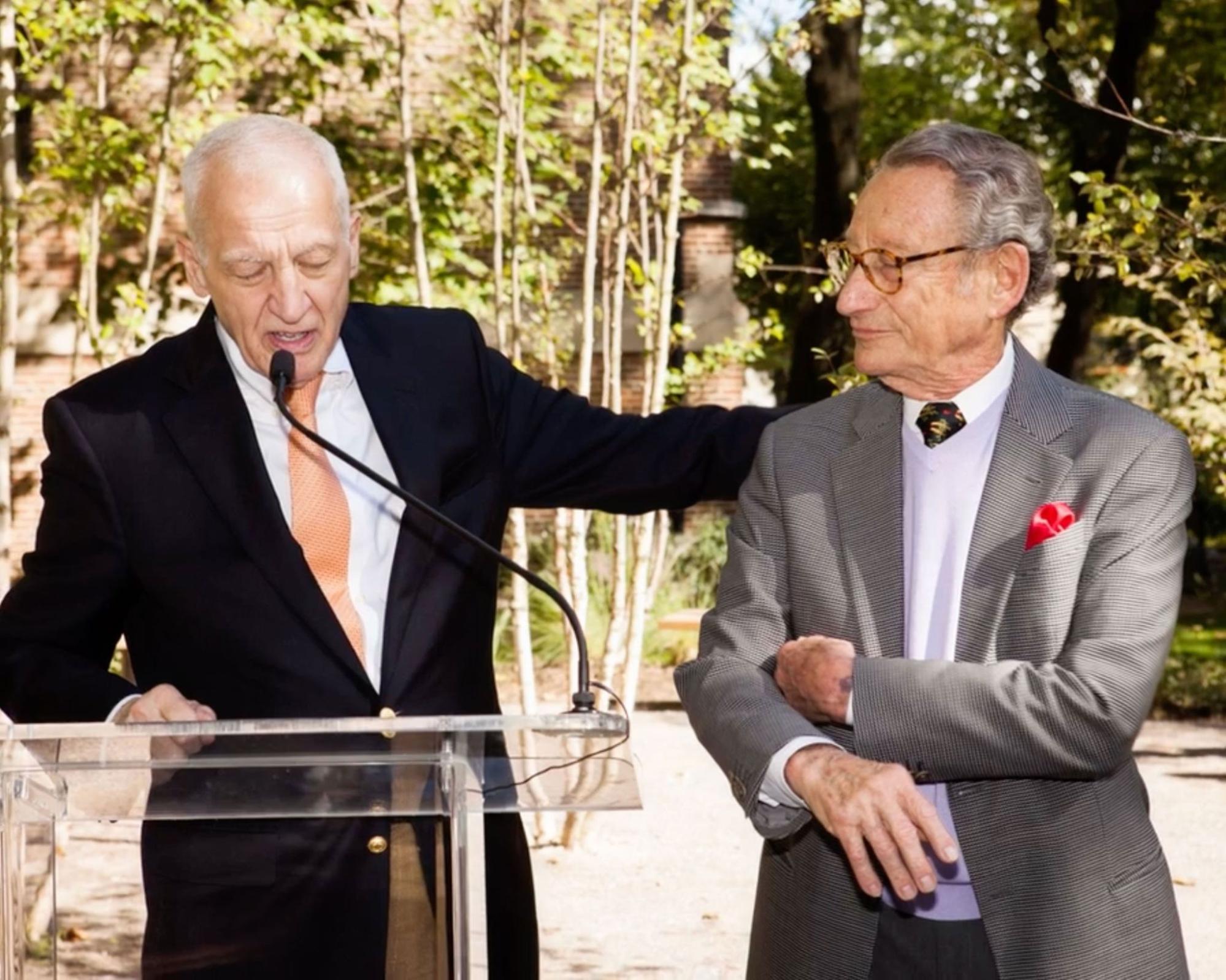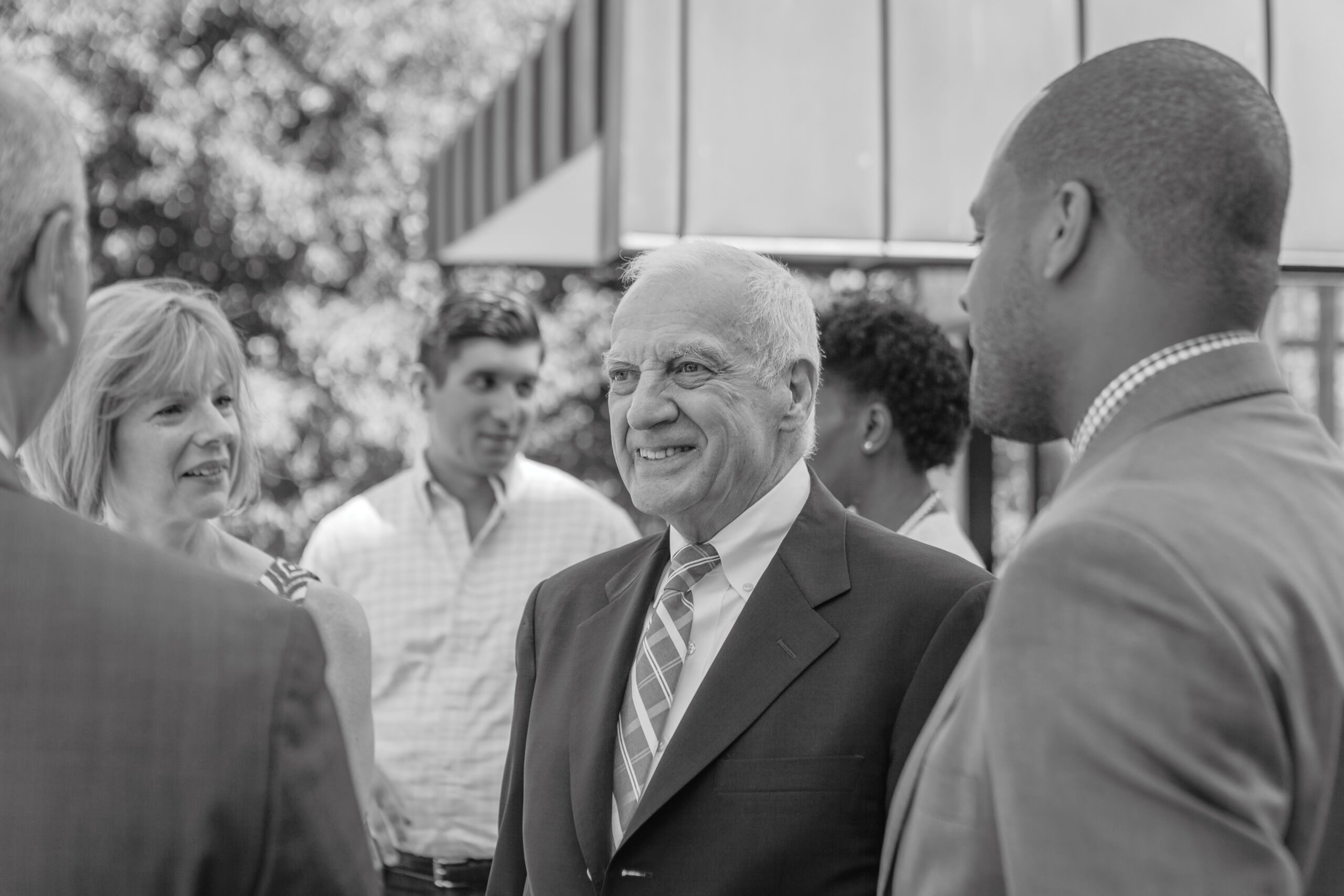The Pratt community remembers the life and legacy of Dr. Thomas F. Schutte, who served as the 11th president of Pratt Institute from 1993 to 2017. He passed away on March 26, 2025, at the age of 89.
Schutte’s 24-year tenure as president was transformative for the Institute. From more than doubling enrollment and improving the physical campus to instilling a prescient focus on sustainability and interdisciplinary studies, he bolstered the Institute’s reputation as one of the world’s most competitive schools of art, design, and architecture. With a vision to the future, he brought a holistic approach to the Institute, where everything from the grounds to the technology of the campus was essential in providing the foundation for a diverse student body to succeed. After stepping down following the 2016–2017 academic year, he was named President Emeritus on July 1, 2017.
“Tom transformed the Institute into a world leader among art and design colleges,” says Pratt President Frances Bronet. “We mourn the loss of an enthusiastic leader and community giant who was Pratt’s strongest champion for a significant period of the Institute’s prestigious history. His incredible passion for education, dedication to innovation, and care for and commitment to the Pratt community, Clinton Hill, Brooklyn, and New York City are a tremendous legacy that will continue to resonate for years to come, inspiring all of us at Pratt as we work together to forge the future of the Institute he loved so much.”
Before arriving at Pratt in 1993, Schutte was the president of Rhode Island School of Design (RISD) for nearly a decade and, prior to that role, was president of Philadelphia College of Art (later University of the Arts) and the assistant dean of The Wharton School of the University of Pennsylvania. He earned a bachelor’s degree in economics and geography from Valparaiso University, an MBA from Indiana University, and a PhD in business administration from the University of Colorado. He later received honorary degrees from St. Thomas Aquinas College (Doctor of Fine Arts) and Pratt (Doctor of Humane Letters, presented at his final Commencement as Pratt president).
While at RISD, he was instrumental in organizing a collective of art and design college presidents that would lead to the establishment of the Association of Independent Colleges of Art and Design (AICAD). It was through this involvement that he came to know Pratt.
When Schutte arrived at Pratt in the early 1990s, it was a critical time for the Institute: Pratt’s facilities had deteriorated, enrollment had waned, and vacant storefronts and crime were high in the surrounding neighborhood. The Institute was facing a deficit after years of budget shortfalls. Schutte, with optimism that would define his presidency, recognized that to cultivate the creativity of its talented students and support its gifted faculty and staff, Pratt needed a learning environment to match. Through his tireless efforts and spirited collaboration, he worked to make the campus and its surrounding neighborhood thrive.

As he told Prattfolio magazine in a 2017 feature, “I thought, Pratt is in a big city. Pratt can be a big school. Pratt had potential with some new vision, some new energy, and some new strength and leadership.”
After his first year as president, he had eliminated the deficit and put Pratt on a new track that would pick up momentum in the following years as he grew the Institute’s endowment, scholarships, and grants. This helped to change Pratt from a mostly local commuter school to a residential campus that attracts students from around the world. In 1999, Stabile Hall was completed with a donation from engineering graduate Vincent A. Stabile, the largest gift to date from an alumnus. In 2011, he led the restoration of 27 historic townhouses on Willoughby Avenue to bolster student housing. One of his culminating projects was the groundbreaking of Emerson Place Residence, a living-learning residence hall for first-year students that opened in 2019.
In 1999, under Schutte’s leadership, Pratt established the Pratt Sculpture Park. The lawns and rotating artworks, open to the public during the day, became a community oasis and the largest sculpture park of its kind in New York City. The grounds were further enhanced by gifts he shepherded, including the landscaping of Newman Mall, the redesign of the Engineering Quadrangle, and other improvements to the gardens and greenspaces. In 2022, Schutte was honored with the naming of the Schutte Plaza on the Brooklyn campus, a tribute to his impact on Pratt and Brooklyn made possible through a generous gift by Trustee Emeritus Bruce Newman.
This consideration for campus resources also involved preserving and elevating Pratt’s architectural heritage through adaptive reuse in a multimillion-dollar master plan. Schutte spearheaded fundraising for the 1998 renovation and refurbishment of the landmarked Memorial Hall as well as the 1996 restoration of Higgins Hall after a fire. A design by architect Steven Holl joined the School of Architecture’s north and south buildings, an attention to academic and architectural cohesion that would continue with the Juliana Curran Terian Design Center, finished in 2007. It unified two previously separate buildings to allow for collaboration across design disciplines. With an orientation to the interior campus lawns—many of the historic buildings faced the former sites of local streets—it also reinforced Pratt’s campus as a place for gathering and community.
“Design was not getting as much visibility at Pratt as it should, and Pratt was so famous in fields of design,” Schutte said in a 2007 interview. “What we did was to say that we will take all the design departments at Pratt, we will find a way to put them into the building, we’ll have interaction among and between the departments . . . so they’ll meet one another and see one another, and there could be a lot of innovation and imagination taking place.”
That unification contributed to the interdisciplinary focus in education at Pratt, where across design departments and throughout schools, students, faculty, and staff have opportunities to work together beyond their specific fields. In 2017, he was presented with the Rowena Reed Kostellow Award as a lifelong champion of design.
One of his final additions to the Brooklyn campus was the transformation of a new Student Union, which rejuvenated a 19th-century structure and gave it a 21st-century interior. Completed in 2018, it brought together three levels of flexible spaces for student organization meetings, events, and exhibitions.
This renewal of Pratt’s campus and resources spurred a major growth of the student body, from 2,992 in 1993 to 4,668 in 2017. The faculty increased to 153 full-time and 1,173 part-time members. The undergraduate and graduate degree offerings almost doubled, including new programs in cutting-edge areas like information experience design, performance and performance studies, placemaking, and game design, as well as minors in social practice and sustainability in art and design. Schutte also identified an opportunity to advance access to a Pratt education with the 1999 formation of PrattMWP College of Art and Design (now Pratt Munson) in Utica, New York, in partnership with Munson-Williams-Proctor Arts Institute.
“Year after year I am awed by the talent and ingenuity of our faculty and students,” Schutte said in the 2012 issue of Prattfolio that commemorated Pratt’s 125th anniversary. “Pratt is already known as a world leader in art and design higher education, but I also see the Institute becoming a global force in addressing societal problems and challenges through the work we do. We’ve already seen this through our efforts with regard to sustainability design education. Tackling issues of sustainability is paramount to many of the artists, designers, library scientists, and other scholars working here today. And I would hope that Pratt would continue to be a place that applies its creativity and knowledge to helping find solutions to the problems of the day.”
Under his tenure, the School of Liberal Arts and Sciences launched its first degree-granting undergraduate and graduate programs, a rare offering from an AICAD school. He led the establishment of specialized centers, including the Design Incubator for Sustainable Innovation, the Center for Sustainable Design Strategies, the Brooklyn Fashion and Design Accelerator, the Consortium for Research and Robotics, the Spatial Analysis and Visualization Initiative, and the Center for Equity and Inclusion, all adding to an inspiring interdisciplinary environment.
“Year after year I am awed by the talent and ingenuity of our faculty and students. Pratt is already known as a world leader in art and design higher education, but I also see the Institute becoming a global force in addressing societal problems and challenges through the work we do.”
—Dr. Thomas F. Schutte
He oversaw the establishment of Pratt’s Information Technology division to provide the technological infrastructure necessary for a competitive education. With the acquisition of a historic seven-story building on 14th Street inaugurated as Pratt Manhattan in 2001, he established a new hub for this creative thinking that would include the School of Information, Arts and Cultural Management, Associate Degree Programs, Construction Management, Design Management, and the School of Continuing and Professional Studies.
As a founding member, trustee, and chair of the Myrtle Avenue Revitalization Project (MARP, now the Myrtle Avenue Brooklyn Partnership) in 1999, he was a major contributor to the community-based revival of the stretch of Myrtle Avenue that runs alongside Pratt’s campus and through Clinton Hill and Fort Greene. It had experienced a decline by the time he became Pratt’s president, and MARP focused first on small measures like cleaning graffiti and then sought retailers to fill the empty storefronts. Civic engagement and making the gates of the campus more porous were both central to Schutte’s work with local community partners.
“We always used the Pratt campus as a place to meet because I wanted them to know that it was a friendly place,” Schutte said of MARP and their discussions with local leaders. “We were here to help, and we were interested in the neighborhood.”
When Myrtle Hall was opened in 2010 on Myrtle Avenue as Brooklyn’s first LEED Gold-certified building of higher education in Brooklyn, it declared Pratt’s commitment to the vitality of the neighborhood. As The New York Times noted in 2011, the building’s broad windows “put Myrtle Avenue on display. Prospective students on their way to the second-floor admissions office pass through a large, light-filled gallery where they can see works by Pratt students and recent alumni.” The Film/Video Building, which opened on Myrtle Avenue in 2015, enriched that relationship.
“The resurgence of Brooklyn is a boon to the arts and a draw for aspiring artists and designers,” he wrote in a 2012 “love letter” to Brooklyn for The Huffington Post, in which he emphasized that he was not just invested in making Pratt a dynamic center for arts and design but radiating that energy into Brooklyn itself and celebrating the borough’s cultural influence. The Brooklyn Chamber of Commerce honored Schutte in 2008 for his leadership in fostering a positive image of Brooklyn. That same year, he was recognized with the National Arts Club Medal of Honor for his promotion of the arts at Pratt and in Brooklyn.
In addition to his work at Pratt, Schutte served as chair of the Brooklyn Arts Council, on the board of advisors of the Historic Districts Council, on the board of the New York Landmarks Preservation Foundation, and on the selection committee for the Byrd Hoffman Water Mill Foundation.
Even after stepping down as president, his groundwork for Pratt as a world-class institution, whether through endowments or acquisitions of land for the future growth of Pratt, endured in shaping the Institute in the years that followed. His commitment to sustainability, too, had a lasting legacy, such as the long-term plan launched in 2016 to divest from fossil fuels. He also put Pratt’s current diversity, equity, and inclusion plan in motion, which continues to make the Institute a vibrant place of learning.

Beyond the many demands of his life’s work and leadership, Schutte found time for personal pursuits. He was an avid collector of early American antiques, a passionate preservationist, an enthusiastic gardener, and a dedicated swimmer.
For many at Pratt, his kindness and compassion for everyone around him were his greatest gifts. “He never looked past anyone,” notes Joseph Hemway, vice president for technology and CIO at Pratt. “All were in his orbit. He believed in dialogue and being curious, and it was those elements that helped him accomplish things and build community at Pratt and in the neighborhood.”
Schutte’s wife, Tess Lansing Schutte, also played a significant role at Pratt during his presidency. As alumni relations associate in Pratt’s Institutional Advancement office for many years, Mrs. Schutte was beloved by the alumni, ensuring a warm connection with the president of their alma mater, particularly in her work with the 50th anniversary classes and the Class Notes section of Prattfolio. She was also a gracious host, opening their home at the Caroline Ladd Pratt House for key Institute events. Sharing her husband’s passion for many initiatives, Mrs. Schutte is remembered as always being at his side for civic and cultural events, and continuing their support and legacy to this day.
In 2013, the Thomas F. and Tess L. Schutte Endowed Scholarship Fund at Pratt Institute was announced, commemorating Schutte’s 20th anniversary at the Institute. The family kindly requests that donations be made to the Schutte Endowed Scholarship Fund. Your generosity will help continue Dr. Schutte’s legacy and support for a cause that was dear to him and to Mrs. Schutte. Contributions may be made at giving.pratt.edu/SchutteScholarshipFund.
Born on December 19, 1935, Schutte was the son of Lindsley R. and Marion Healy Schutte of Rochester, New York. He is survived by his loving wife of 66 years, Tess Lansing Schutte; their two sons, Douglas and David; seven grandchildren and great-grandchildren; and Schutte’s sister, Caroline Chandler.
His funeral was held on Sunday, March 30, at the First Presbyterian Church in Jamestown, New York, followed by a private burial at White Haven Memorial Park in Pittsford, New York. Details for a memorial service at Pratt Institute in Brooklyn will follow.
